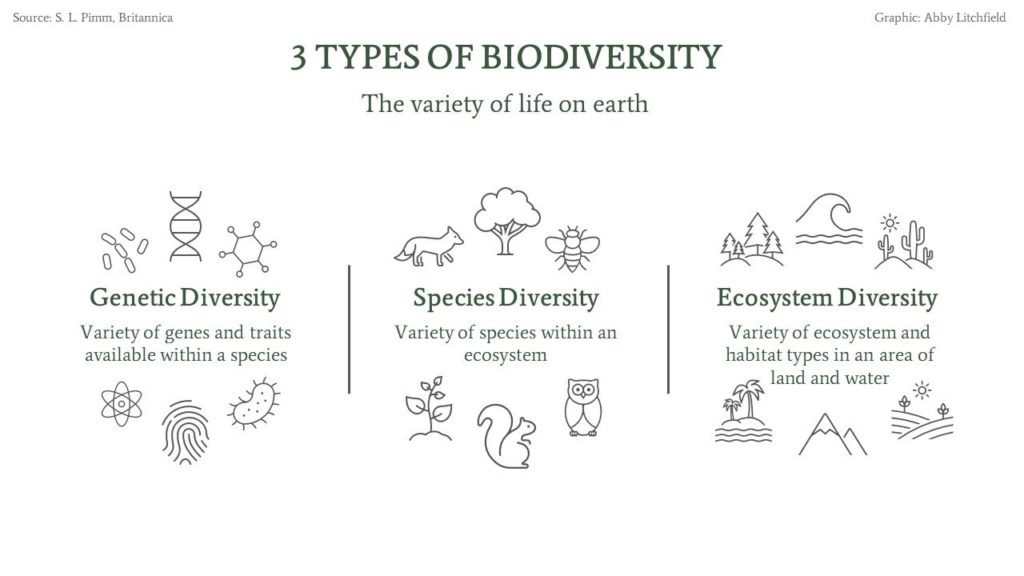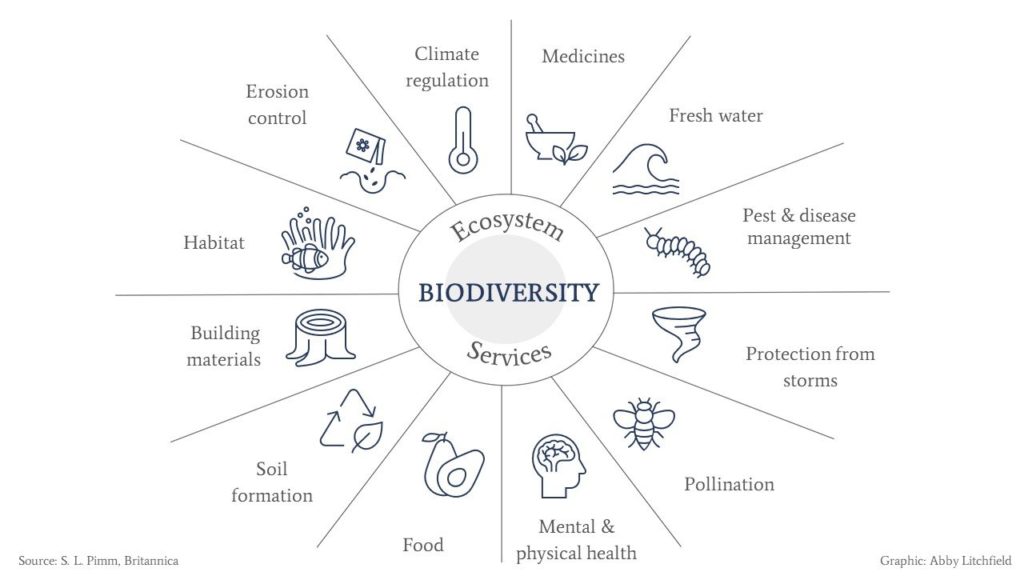This article makes it easy to understand what biodiversity is and why it’s so important, by providing a simple and visual definition.
“The Basics” provides essential knowledge about core business sustainability topics.
Growing up in South Africa, I have always been surrounded by nature — a term that is often used synonymously with biodiversity. So, like everyone, I have lived with biodiversity in my life. Biodiversity is the natural world that surrounds us. It is the variety and diversity of life on Earth.
What is Biodiversity in Simple Words?
Here’s the simplest description of biodiversity: the variety of life on Earth. According to the United Nations Convention on Biodiversity, is the “variability among living organisms.” This includes “diversity within species, between species and of ecosystems.” It’s all the plants and animals that interact with each other and the physical world around them in areas called ecosystems.
You can think in terms of genetic, species, and ecosystem diversity. All are types of “biodiversity.”
On a genetic level, biodiversity is what makes you different from everyone you know. Each individual has a unique mixture of genes.
On a species level, it’s all the different plants and animals that exist – from a western lowland gorilla to humpback whale or a portobello mushroom.
Ecosystems are areas of biodiversity where plants and animals interact with the environment in different ways. Take for example a coral reef ecosystem. There you may find a variety of corals, fish, rays, turtles, jellyfish, urchins, seaweeds, phytoplankton, and algae – all interacting within the ecosystem.
The picture shows these different types of biodiversity.

How Different Types of Diversity Fit Together
The types of diversity are interwoven, with each kind coexisting and depending on the other.
Ecosystems come in different forms, which occur in different areas. (For example, Finland has woodlands, Seychelles has coral reefs, Kenya is rich in grasslands and Mexico has deserts.)
Each ecosystem has certain species of plants, animals and insects — its own unique biodiversity. You’ll find many species that occur there and nowhere else on Earth: these are called endemic species. In the grasslands of Kenya, you may find lions, antelope, acacia trees and termites. You’ll even find different species of fungi and bacteria.
If you look deeper still, you’ll find a final level of diversity within each of those grassland species. For example, antelope have subspecies of oryx, sable and roan antelope.
Each type of plant and animal has specific preferences for where they like to live, and what they like to eat. Certain species can only survive in very specific habitats, altitudes or temperatures. Some are also very sensitive to changes in their habitats. For example, frogs are so sensitive to changes in water quality, because of their absorptive skins, that they can die or develop deformities if the water is slightly polluted.
Biodiversity comes together in ecosystems
It’s easy to list examples of plants and animals on a species level. But explaining the intricacies of ecosystems and how they function can be a little complex. That’s because over time, ecosystems and their processes have developed a way of being stable or balanced.
Each ecosystem needs a diversity of plants and animals and enough habitat area to keep functioning optimally. Many ecosystems across the world have been so disrupted and fragmented that they risk collapse. This, in turn, can have dire consequences – especially because of the multitude of benefits we receive from ecosystems.
Changes to one aspect of an ecosystem can result in changes in other parts too — but the effects of these disturbances can be tricky to predict. Sometimes, ecosystems can adapt to these changes — particularly if they are biodiverse and therefore more resilient. But certain changes can spark an ecosystem collapse.
Why Is Biodiversity Important?
When ecosystems are healthy, functioning, and resilient, they provide a wide range of services. These can include clean air and water, food, medicines, storm buffers and even carbon storage.
People benefit immensely from biodiversity in their daily lives – for example, many jobs and livelihoods depend on ecosystems and biodiversity. In a companion article, I’ve written about the importance of biodiversity: how humans rely on biodiversity and ecosystems for the food we consume, for medicines we use to improve our health, for materials we need to make clothes and almost every product you can think of.
The picture shows biodiversity at the centre, surrounded by the many services that ecosystems provide.

Today, biodiversity is being lost rapidly due to various threats. There’s been a 68% decline in global populations of mammals, fish, birds, reptiles, and amphibians since 1970 and over a million plants and animals are threatened with extinction.
Individuals and organizations need to understand what’s at risk when biodiversity and ecosystems are degraded or destroyed. For business, the ability to continue operating and the sustainability of their supply chains are at risk.
Organizations need to identify opportunities to become more biodiversity-friendly, circular, and sustainable. After all, investment in biodiversity can lead to new markets, reduced operating costs, and more sustainable supply chains.
Case Study: Understand the Coral Reef Ecosystem
To illustrate the intricate nature of ecosystems, let’s look at an example of a change (or disturbance) within an ecosystem to see its effects.
As an example, journey with me into a coral reef ecosystem. Corals around the world are beginning to bleach and die because of warming ocean water, pollution, invasive species and other human causes.
As the corals die, the fish that live there will no longer have places to live in or food to eat as they’re growing (25% of marine species spend some part of their life cycle in reefs).
That can have cascading effects for the many animals and plants living in the coral reef ecosystem. As those coral-eating fish die off, the animals that prey on the fish will also have their food supply interrupted.
As this coral reef ecosystem is impacted, so too are businesses that rely on its services. If this coral reef ecosystem collapsed, it could impact the local fisheries sector that will no longer be able to harvest as much catch.
The local ecotourism sector may be impacted if visitors no longer see it as an attractive destination for diving and viewing the reef and its species. Nearby coastal developments could also be more vulnerable to floods and storms as coral reefs offer protection in this regard.
This example also highlights the many opportunities for businesses to conserve and enhance biodiversity. Protecting, restoring and sustainably managing the coral reef allows the ecotourism sector to continue to attract visitors, the fisheries sector to protect their supply chain, and the insurance sector to reduce the number of claims for storm damage and coastal flooding.
Some businesses are also developing new markets based on protecting and restoring reefs. For example, Coral Vita receives funding to grow and transplant new corals.
How to Support Biodiversity
While we all should do what we can in our lives to support biodiversity, businesses are particularly important actors because of their resources and impact. How can they prevent biodiversity loss and restore and sustainably manage ecosystems?
Some businesses are protecting and restoring biodiversity through their supply chains, innovative product design and sustainable sourcing – others through their operations and processes. And some are creating new markets for biodiversity-friendly products and services. NBS’s companion article on the importance of biodiversity describes more of these initiatives.
For more inspiration, some of the largest corporations in the world are collaborating on biodiversity-friendly initiatives. The One Planet Business for Biodiversity initiative (OP2B) aims to protect and restore biodiversity within company supply chains and product portfolios, with Google, L’Oreal, Mars, Inc., Unilever, Nestle S.A., Kellogg Co. and Danone S.A. among the participating businesses.
The chairman of the OP2B, Emmanuel Faber, remarks on the importance of businesses taking collective action on biodiversity loss:
“The global food and agricultural ecosystem is critically dependent on biodiversity: from soil regeneration through to water filtration, pest control and pollination, among many of the other building blocks of life on earth. According to many recent scientific studies, we have ten years to reset our course and bend the curve on climate change and wild and cultivated biodiversity loss. We need a collective effort now.”
About the Series
“The Basics” provides essential knowledge about core business sustainability topics. All articles are written or reviewed by an expert in the field. The Network for Business Sustainability builds these articles for business leaders thinking ahead.
Resources to Build Your Knowledge on Biodiversity
Almond, R.E.A., Grooten, M., & Petersen, T. (Eds.). 2020. Living planet report 2020: Bending the curve of biodiversity loss. WWF.
Bishop, J., Kapila, S., Hicks, F., Mitchell, P., & Vorhies, F. 2008. Building biodiversity business. Shell International Limited and the International Union for Conservation of Nature.
Brondizio, E.S., Settele, J., Díaz, S., & Ngo, H.T. (Eds.). 2019. Global assessment report on biodiversity and ecosystem services of the Intergovernmental Science-Policy Platform on Biodiversity and Ecosystem Services. IPBES. https://doi.org/10.5281/zenodo.3831673.
World Business Council for Sustainable Development. 2020. The circular bioeconomy: A business opportunity contributing to a sustainable world.
World Business Council for Sustainable Development. 2018. The new big circle: Achieving growth and business model innovation through circular economy implementation.



Add a Comment
This site uses User Verification plugin to reduce spam. See how your comment data is processed.This site uses User Verification plugin to reduce spam. See how your comment data is processed.